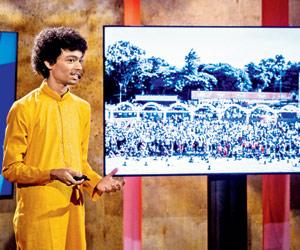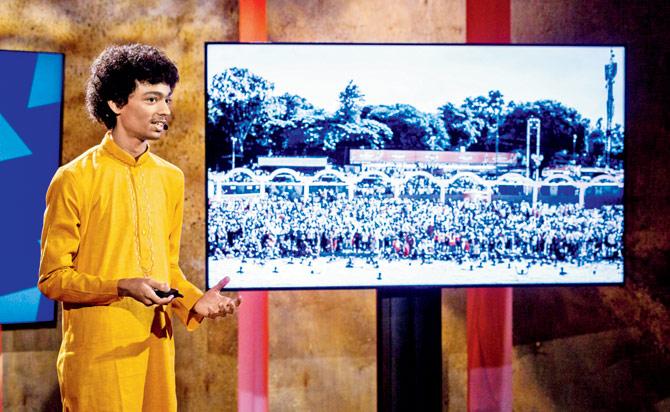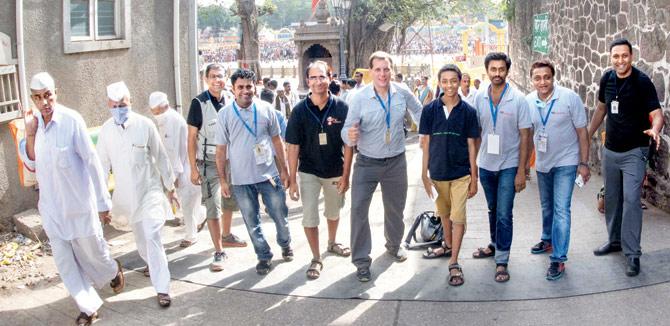A teen from Nashik talks of how his invention can help prevent stampedes like the one at Elphinstone station


Nilay Kulkarni discussed his invention at the TED talk in New York
Nashik-based Nilay Kulkarni's earliest memory of the Kumbh Mela wasn't a pleasant one. Back in 2009, when he was still in Std V, he recalls seeing news flashes of how 10 people had died at a stampede during the mega religious festival, which is celebrated in accordance with the Hindu calendar. The number of casualties rose to 39 in 2013. "I remember my grandfather telling me that going by the situation, more people would die during the next fair. It unsettled me. I wanted to find a solution to this," said Kulkarni.
Today, the 18-year-old self-taught programmer, who is the co-founder and chief technical officer of Ashioto Analytics — a start-up that finds tech solutions for crowd management — has built a footfall-counting mat to prevent human stampedes during the Kumbh Mela in Nashik, which sees over 12 lakh visitors. Kulkarni said that the mat has the potential to prevent disasters like the one that took place in Elphinstone Road in September last year, and authorities can lay the mats on the recently opened bridge, which has been constructed by the Army.

Kulkarni, along with the local tech team, conducted a trial run of his specialised sensor mat at the Kumbh Mela in Nashik in 2015
Earlier this year, he was invited to the TED talk at New York to present his idea. "Ashioto literally translates to footsteps in Japanese. It's something that Google translator threw up when we were looking for a suitable title for the company," he said.
Kulkarni's idea took form in 2014 during an MIT Kumbathon effort led by MIT Media Lab and a group of Nashikkars, who wanted to find a solution to the stampede problem at the mela. "We wanted to build a mechanism that could tell us how many people are moving, at what rate and in which direction. If this data is available from multiple points, we could create a heat map or a matrix with colours that could tell us the density at a particular location," he said. This way, they could predict a stampede.
When he set out to find the technology to do it, there were hurdles. Several options such as radio-frequency identification (RFID) token coins, image-processing mechanism and camera were struck off the list due to their impracticality and mounting cost.
A mat to the rescue
After weeks of brainstorming, Kulkarni thought of building a sensor mat that showed the footfall at a particular point. "The cloud-based crowd system could count the number of people walking over a specialised sensor mat, which was laid on a road," he said. The trials were done at a local temple that would normally see a huge crowd. The mat counted 78,000 people, which in fact, was correct.
"The authorities were impressed so we decided to replicate it at the mela in 2015," he said. The mats were installed near the Godavari River to track people exiting after taking a dip. On three days, the mechanism counted more than five lakh people at five exit routes out of 20 in 18 hours and helped the police take a few crowd-routing decisions.
Securing railway stations
Through the app, Kulkarni has now identified multiple opportunity areas namely retail stores, religious places, concerts and railway stations, where crowds can be effectively managed.
Speaking about how the mat can be used at FOBs in Mumbai's crowded suburban stations, Kulkarni said, "If we put sensors in the mat to count the rate of people flowing in and flowing out, we can calculate the crowd-density of the station. These mats can be placed at both platforms and railways bridges." He added, "Based on the sensors, we can predict if a particular pattern of the moving crowd eventually leads to a dangerous density and accordingly, alert the authorities. The mat can synchronise with the train timings to improve predictions."
Also Read: 'Blue Whale Suicide Game' Creator Reveals Why He Invented The Game
Catch up on all the latest Mumbai news, crime news, current affairs, and also a complete guide on Mumbai from food to things to do and events across the city here. Also download the new mid-day Android and iOS apps to get latest updates
 Subscribe today by clicking the link and stay updated with the latest news!" Click here!
Subscribe today by clicking the link and stay updated with the latest news!" Click here!









